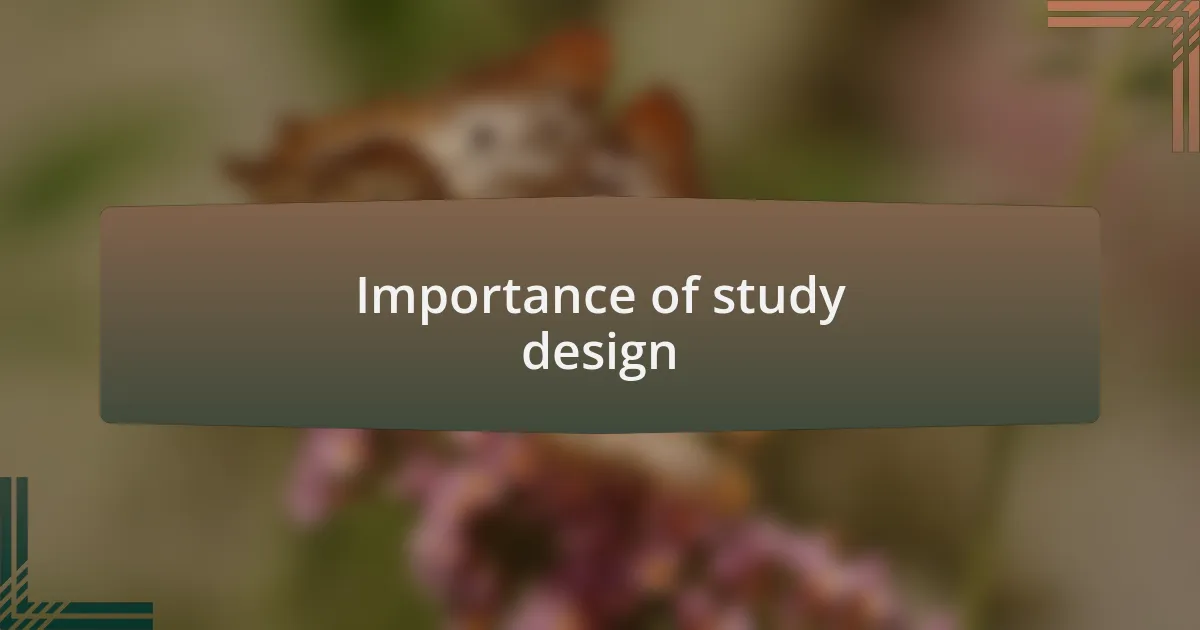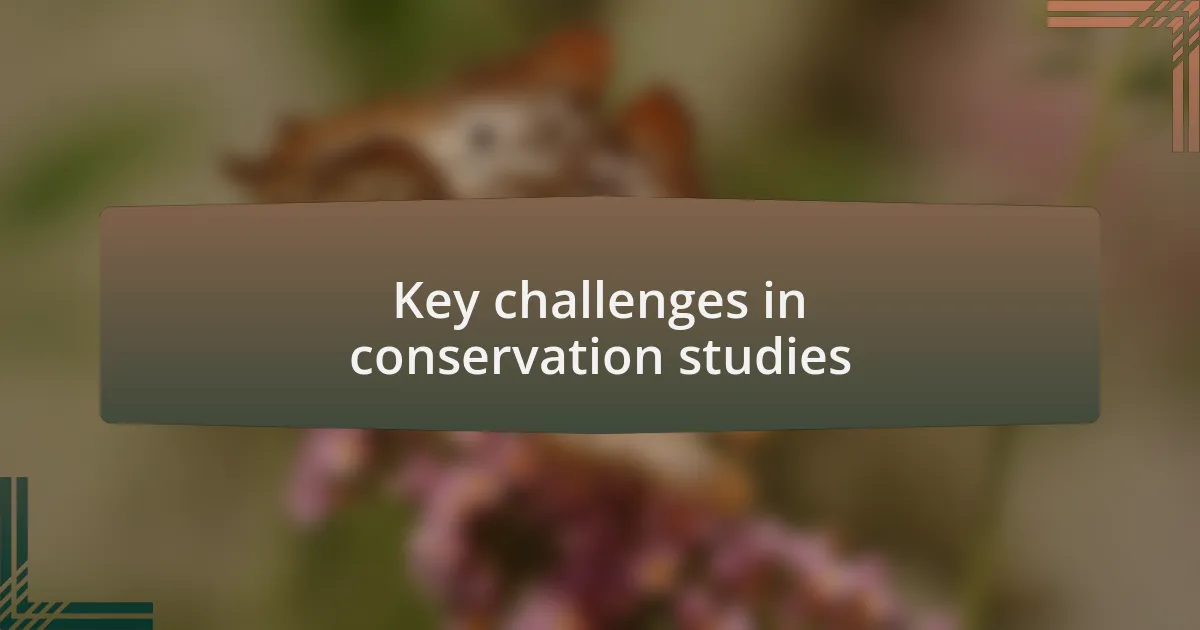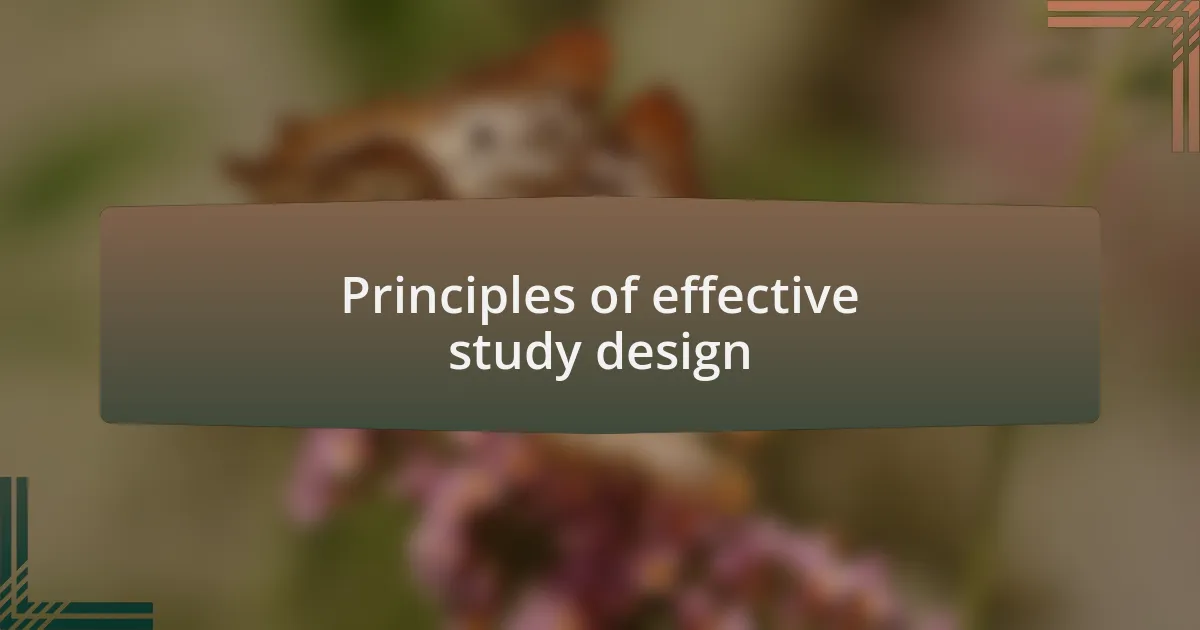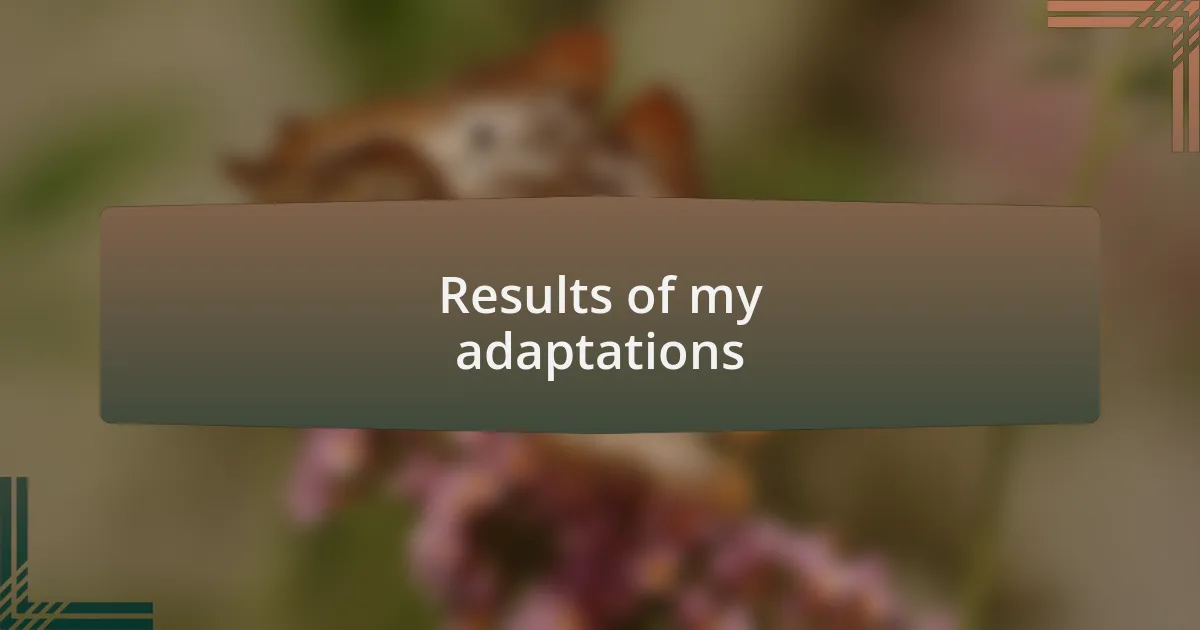Key takeaways:
- Nearly 50% of butterfly species are declining due to habitat loss, climate change, and pesticide use, highlighting the urgency for conservation efforts.
- Effective study design is crucial for gathering relevant data, minimizing biases, and fostering collaboration among stakeholders.
- Adaptability in research methods can uncover unexpected insights, such as variations in butterfly behavior linked to environmental conditions.
- Engaging local communities and leveraging their knowledge enriches research and strengthens conservation strategies.

Understanding butterfly conservation
Butterfly conservation is crucial because these beautiful creatures are more than just a delight to our eyes; they are key indicators of ecosystem health. I remember wandering through a local meadow as a child, captivated by the vibrant flutter of wings. That innocent joy sparked my lifelong appreciation for nature, reminding me that if we don’t protect their habitats, their flitting presence might vanish altogether.
One of the most alarming facts I discovered is that nearly 50% of butterfly species are in decline, primarily due to habitat loss, climate change, and pesticide use. As I conducted my research, I couldn’t help but wonder: how many future generations will miss the thrill of chasing butterflies in a sunlit field? This urgency drives the need for conservation efforts that not only protect existing habitats but also restore ecosystems that have been fragmented.
Moreover, engaging communities in butterfly conservation can foster a greater connection to nature. I’ve seen firsthand how educational programs can ignite a passion for these insects. Watching children marvel at the transformation from caterpillar to chrysalis and to butterfly evokes a sense of wonder that is vital for nurturing future conservationists. If we instill this appreciation early on, we create stewards of the environment who will advocate for these delicate beings for years to come.

Importance of study design
The design of a study is foundational for understanding and interpreting the results. From my experience, an effective study design not only maps out the methodology but also aligns with the specific goals of conservation efforts. Have you ever faced the frustration of collecting data that ultimately didn’t answer your pressing questions? This emphasizes the critical need to tailor your approach to the unique challenges posed by butterfly conservation.
A thoughtful study design ensures that researchers gather relevant data while minimizing biases that could skew the findings. I recall a project where we implemented a control group that mirrored the variables of our primary study area. This approach significantly clarified the impact of habitat restoration strategies, revealing insights we wouldn’t have captured without that structured framework. It’s fascinating how a few extra steps in planning can lead to profound revelations about our fragile ecosystems.
Moreover, a well-crafted study design can inspire collaboration among different stakeholders. I vividly remember presenting our findings to local conservation groups, who were eager to implement our recommendations. The enthusiasm was contagious, reinforcing my belief that transparent, reliable research empowers communities to take meaningful action. Isn’t it rewarding to see science spark real change in the fight for butterfly conservation?

Key challenges in conservation studies
Conservation studies often grapple with the challenge of limited funding and resources. In one project, we faced the daunting reality of budget constraints, which forced us to prioritize certain areas of study over others. This experience made me appreciate how critical it is to allocate resources wisely, ensuring we focus on the most pressing conservation needs. Have you ever wondered how much more we could achieve with a little extra funding?
Another significant challenge lies in the ever-changing environmental conditions influencing butterfly populations. On one occasion, during a particularly unseasonably warm winter, we witnessed an unexpected increase in certain species while others dwindled. This fluctuation taught me that adaptation is essential in conservation research. How can we truly understand these delicate dynamics when nature often defies our expectations?
Furthermore, engaging the local communities can be a double-edged sword in conservation studies. I remember a time when we had the opportunity to collaborate with local farmers, which initially seemed promising. However, integrating their insights revealed differing priorities that complicated our efforts. Have you ever found that bringing in diverse perspectives enriches your research, even when it creates tension? Balancing these relationships is crucial, as their firsthand knowledge can ultimately drive more effective conservation strategies.

Principles of effective study design
Designing an effective study involves clarity of purpose. When I set out to investigate butterfly populations, I learned the importance of asking specific questions from the outset. This focus guided my data collection, ensuring that every aspect of the study directly contributed to understanding the species I was examining. Have you ever noticed how a clear goal can steer your actions toward meaningful outcomes?
Another principle that stands out is the necessity of robust sampling methods. During one of my projects, I realized how flawed our initial sampling designs led us to overlook crucial data. This mishap drove home the importance of having a well-structured approach to data collection—one that captures true population dynamics rather than mere anomalies. What strategies have you found effective for ensuring accurate representation in your studies?
Lastly, I’ve come to appreciate the value of flexibility in study design. In one instance, my team had to pivot our research focus when unexpected environmental changes shifted butterfly behaviors. This experience taught me that while planning is essential, being adaptable can lead to discovering unanticipated insights. Don’t you think that the ability to adjust our designs as new information arises is a cornerstone of effective research?

My initial study approach
My initial study approach was grounded in a comprehensive literature review. I spent countless evenings poring over previous research to grasp what had been explored and where gaps existed. This background research not only fueled my curiosity but also helped me refine my research questions. Have you ever felt that rush when you uncover key insights that shape your entire approach?
In the beginning, I employed a mixed-methods strategy combining quantitative data from field surveys with qualitative observations from nature walks. I vividly remember one weekend spent observing butterflies flitting from flower to flower; it was a joyful reminder of why I embarked on this journey. The blend of numbers and narratives felt natural, enabling me to capture both the statistical trends and the intimate stories that define these creatures. Don’t you find that a holistic approach can breathe life into raw data?
Another element I embraced was community involvement, reaching out to local butterfly enthusiasts for insights. Their passion and firsthand experiences provided invaluable perspectives that my academic training alone couldn’t offer. One discussion with a seasoned butterfly watcher opened my eyes to behaviors I had overlooked, reinforcing the idea that collaboration enriches our understanding. Have you ever drawn inspiration from a casual conversation that altered your perspective?

Adaptations made during the study
During the study, I made several important adaptations based on early observations that challenged my initial assumptions. For instance, I noticed that certain butterfly species were more active during specific times of the day than I had anticipated. This realization led me to adjust my fieldwork hours, allowing me to collect data during those peak activity periods. Have you ever had to shift your plans based on unexpected insights? It can be a rewarding experience, turning initial confusion into clarity.
Another significant adaptation involved altering my data collection methods. Early on, I relied heavily on traditional survey techniques, but I quickly found that the butterflies’ elusive behaviors weren’t always captured through standard metrics. Recognizing this limitation, I started incorporating video recordings to observe their interactions in a more dynamic way. This switch not only enriched my data but also added an exciting layer of engagement to my research. Have you ever tried a new approach that transformed your understanding of a subject?
Lastly, I found that the weather significantly impacted butterfly activity, which wasn’t something I had deeply considered at first. On days of heavy rain or wind, butterfly sightings dwindled dramatically. I decided to take meticulous weather notes alongside my observations, allowing me to draw correlations between climate conditions and butterfly behavior. This insight reminded me of always embracing the unpredictable nature of outdoor research. Have you ever learned to adapt to the whims of nature in your pursuits? It’s a humbling experience that underscores the importance of flexibility in research design.

Results of my adaptations
The adaptations I implemented yielded significant insights into butterfly behavior that I hadn’t anticipated. For instance, by collecting data during peak activity times, I discovered that some species were not only more abundant but also exhibited unique behaviors in those moments. This revelation was eye-opening, prompting me to align my fieldwork schedule with nature’s patterns. Have you ever felt the thrill of witnessing something remarkable in the wild that shifted your understanding?
Switching to video recordings was another transformative change. Initially, I was skeptical about whether this method would provide meaningful data. However, reviewing the footage revealed intricate social behaviors among butterflies that my previous methods simply couldn’t capture. It was like uncovering a hidden world; I couldn’t help but feel a rush of excitement each time I pressed play. Has a new perspective ever filled you with wonder as you learned more about a familiar topic?
Finally, correlating weather conditions with butterfly activity proved to be a game-changer. I distinctly remember a particularly windy day when I sat there with my notebook, noticing that even the heartiest butterflies were absent. This pushed me to refine my data collection approach further and establish a clearer relationship between environmental factors and butterfly behavior. It’s fascinating how nature often demands a keen awareness of its changing elements. Have you ever stopped to consider how external factors might impact your work or passions in unexpected ways?